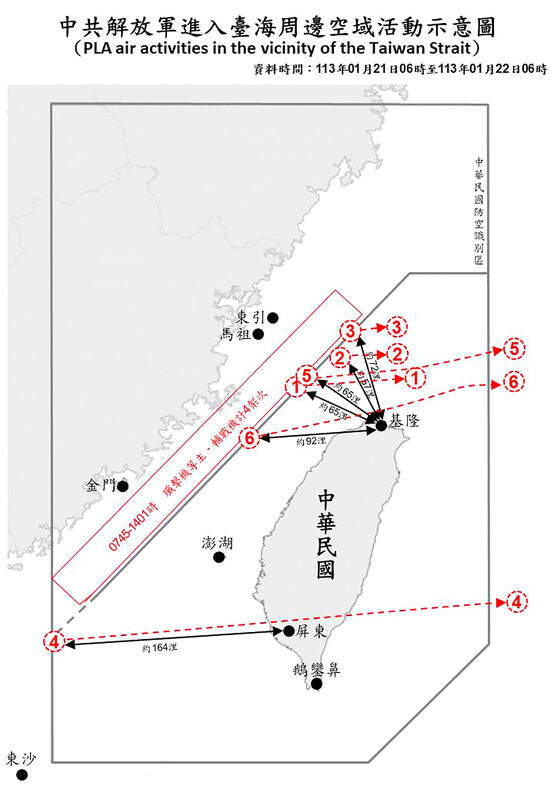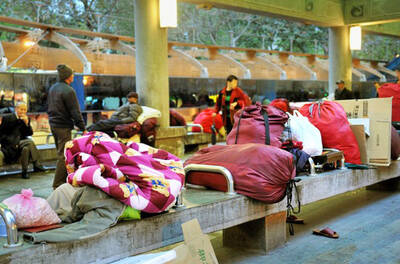About a month before Taiwan’s presidential election in January, China began sending intruders over the Taiwan Strait: more than 100 balloons, some of which passed through the nation’s airspace or busy air corridors for civil aviation.
Experts say the balloons could be psychological warfare, carry surveillance tools or simply gather meteorological data. On some days, as many as eight were detected within a few hours; at other times, weeks passed without any balloons at all.
In the week leading up to the election on Jan. 13, an average of three balloons were spotted each day. On April 11, they stopped altogether.

Photo courtesy of the Ministry of National Defense
The increased frequency has raised alarms domestically and abroad.
A senior Taiwanese security official briefed on the matter said tat Chinese balloon flights near Taiwan took place on an “unprecedented scale” in the weeks leading up to the election and described the incidents as part of a Chinese pressure campaign — so-called “gray zone” warfare designed to exhaust a foe using irregular tactics without open combat.
Taiwan is to inaugurate its new president, William Lai (賴清德), on Monday. China has a strong dislike of Lai, believing him to be a dangerous “separatist.”
The Chinese Ministry of National Defense did not respond to a request for comment.
China’s Taiwan Affairs Office referred reporters to its comment on Jan. 31, in which it dismissed complaints about the balloons, saying they were for meteorological purposes and should not be hyped up for political reasons.
Before Dec. 8, balloon data were not made public, meaning that historical comparisons are impossible.
However, Mainland Affairs Council spokesman Jan Jyh-horng (詹志宏) told reporters that in the past, a balloon would be spotted “maybe once a month.”
Between December last year and last month, more than four balloons were detected on eight separate days. In total, just over 100 balloons were flown during that period.
Three Taiwanese officials briefed on the matter confirmed that the number of Chinese balloons had increased significantly in the past few months.
The majority are weather balloons collecting atmospheric data, including wind, temperature and humidity, they said, but Taiwan still sees them as Chinese harassment.
The balloons have flown at an altitude of 3.4km to 11.6km, with a mean altitude of 6.8km — well under the usual altitude for meteorological balloons.
According to the US National Weather Service, weather balloons typically reach altitudes of more than 30.5km.
“Sending them over at that kind of altitude is dangerous,” said Alexander Neill, a strategic adviser on Indo-Pacific geopolitics who was formerly at the International Institute for Strategic Studies and the Royal United Services Institute. “You are within air traffic corridors and the potential for a collision is concerning.”
Jan agreed, saying that the balloons are a threat to aviation safety.
“They fly very slowly, while planes move speedily,” he said. “It could be too late when they were spotted, if they were sucked into the engines.”
China’s most frequent form of “gray zone” activity has been the almost daily air force and navy missions in the waters and skies around Taiwan, forcing the nation’s armed forces to repeatedly scramble to see off the intruders.
Other tactics Taiwanese officials have expressed concern about include sand dredging close to Lienchiang County, which is near the Chinese coast.
A second senior Taiwanese senior security official said, citing intelligence gathered by Taiwan, that the data potentially collected by the balloons would be useful for the Chinese People’s Liberation Army’s rocket forces, because atmospheric factors could affect missile launches.
“If China was planning to mount an air assault onto Taiwan, they would need to understand the meteorological conditions and wind patterns of the island,” Neill said.
Democratic Progressive Party Legislator Wang Ting-yu (王定宇), who is co-convener of the legislature’s Foreign Affairs and National Defense Committee, told reporters that balloons are hard for military radars to detect unless their sensitivity is set to high levels.
However, ultra-sensitive radars are likely to spot objects such as birds, and as a result, Taiwan’s military might miss other vital targets such as incoming missiles.
“It’s a challenging task,” Wang said.
Raymond Kuo (郭泓均), director of the RAND Corp’s Taiwan Policy Initiative, said he thinks the purpose of the balloons is primarily psychological.
“I personally am skeptical of what additional intelligence China could get from balloons that they couldn’t get from other platforms,” Kuo said. “I think they’re mostly meant to signal to Taiwan that they can’t even defend their airspace.”

Costa Rica sent a group of intelligence officials to Taiwan for a short-term training program, the first time the Central American country has done so since the countries ended official diplomatic relations in 2007, a Costa Rican media outlet reported last week. Five officials from the Costa Rican Directorate of Intelligence and Security last month spent 23 days in Taipei undergoing a series of training sessions focused on national security, La Nacion reported on Friday, quoting unnamed sources. The Costa Rican government has not confirmed the report. The Chinese embassy in Costa Rica protested the news, saying in a statement issued the same

Taiwan’s Liu Ming-i, right, who also goes by the name Ray Liu, poses with a Chinese Taipei flag after winning the gold medal in the men’s physique 170cm competition at the International Fitness and Bodybuilding Federation Asian Championship in Ajman, United Arab Emirates, yesterday.

A year-long renovation of Taipei’s Bangka Park (艋舺公園) began yesterday, as city workers fenced off the site and cleared out belongings left by homeless residents who had been living there. Despite protests from displaced residents, a city official defended the government’s relocation efforts, saying transitional housing has been offered. The renovation of the park in Taipei’s Wanhua District (萬華), near Longshan Temple (龍山寺), began at 9am yesterday, as about 20 homeless people packed their belongings and left after being asked to move by city personnel. Among them was a 90-year-old woman surnamed Wang (王), who last week said that she had no plans

TO BE APPEALED: The environment ministry said coal reduction goals had to be reached within two months, which was against the principle of legitimate expectation The Taipei High Administrative Court on Thursday ruled in favor of the Taichung Environmental Protection Bureau in its administrative litigation against the Ministry of Environment for the rescission of a NT$18 million fine (US$609,570) imposed by the bureau on the Taichung Power Plant in 2019 for alleged excess coal power generation. The bureau in November 2019 revised what it said was a “slip of the pen” in the text of the operating permit granted to the plant — which is run by Taiwan Power Co (Taipower) — in October 2017. The permit originally read: “reduce coal use by 40 percent from Jan.